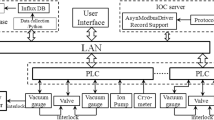Abstract
High intensity D–T fusion neutron generator (HINEG) is a high voltage accelerator-based D–T fusion neutron facility, which provides a significant platform for nuclear technology researches. The steady operation of HINEG vacuum system is enormously significant for its beam quality. In this paper, in order to eliminate the drawbacks and disadvantages caused by the time delay element in vacuum system, a gain adaptive compensation control strategy was proposed for vacuum system. In accordance with vacuum-pumping mechanism, the vacuum dynamic equilibrium equation was transformed from the time domain to the complex frequency domain by means of Laplace transformation, and the system transfer function in vacuum pumping process was derived. The experimental results analyses showed that the overshoot and settling time are eliminated effectively with this gain adaptive compensation control algorithm, which indicated that the system self-regulation and anti-interference performances were greatly improved.











Similar content being viewed by others
References
J. Pivarč et al., Vacuum system of the multipurpose 14 MeV neutron source in Bratislava: design and status. Vacuum 36, 527–529 (1986)
Y. Wu, F.D.S. Team, Design analysis of the China dual-functional lithium lead (DFLL) test blanket module in ITER. Fusion Eng Des 82, 1893–1903 (2007)
Y. Wu, Design status and development strategy of China liquid lithium-lead blankets and related material technology. J Nucl Mater 367, 1410–1415 (2007)
Y. Wu et al., A fusion-driven subcritical system concept based on viable technologies. Nucl Fusion 51, 1030–1036 (2011)
Y. Wu, F.D.S. Team, Conceptual design activities of FDS series fusion power plants in China. Fusion Eng Des 81, 2713–2718 (2006)
Y. Wu, et al., Development strategy and conceptual design of China Lead-based Research Reactor. Ann Nucl Energy 87, 511–516 (2016)
Y. Wu, Conceptual design and testing strategy of a dual functional lithium-lead test blanket module in ITER and EAST. Nucl Fusion 47, 1533–1539 (2007)
Y. Wu et al., Development of accurate/advanced radiotherapy treatment planning and quality assurance system (ARTS). Chin. Phys. C 32, 177–182 (2008)
Y. Wu et al., CAD-based Monte Carlo program for integrated simulation of nuclear system SuperMC. Ann. Nucl. Energy 82, 161–168 (2015)
Y. Wu et al., A discrete ordinates nodal method for one-dimensional neutron transport calculation in curvilinear geometries. Nucl. Sci. Eng. 133, 350–357 (1999)
Y. Wu, F.D.S. Team, CAD-based interface programs for fusion neutron transport simulation. Fusion Eng. Des. 84, 1987–1992 (2009)
W. Wang et al., Spectrum analyses and diagnoses of 350 kV HVPS ripples on high intensity D–T fusion neutron generator. J. Fusion Energ. 34, 989–994 (2015)
W. Wang et al., Design of the personnel radiation safety interlock system for high intensity D–T fusion neutron generator. J. Fusion Energ. 34, 346–351 (2015)
D. Schmied, Vacuum control and operation of the ESRF accelerator system. Vacuum 60, 123–129 (2001)
Y. Wang, Vacuum Technology (Sichuan Publishing House of Science and Technology, Sichuan, 1985), pp. 243–252
F. Golnaraghi, B. Kuo, Automatic control systems. Complex Variables 2, 426–440 (2009)
L.H. Keel, S.P. Bhattacharyya, A Bode plot characterization of all stabilizing controllers. Autom. Control IEEE Trans. 55, 2650–2654 (2010)
Lam QM, Stamatakos N, Woodruff C, Ashton S. Gyro modeling and estimation of its random noise sources, in AIAA Guidance, Navigation, and Control Conference and Exhibit (AIAA Inc. Texas, USA, 2003)
J. Normey-Rico, C. Bordons, E. Camacho, Improving the robustness of dead-time compensating PI controllers. Control Eng. Pract. 5, 801–810 (1997)
Omatu S, Fujinaka T, Yoshioka M. Neuro-PID control for inverted single and double pendulums, in Systems, Man, and Cybernetics, 2000 IEEE International Conference on (IEEE, 2000), pp. 2685–2690
Acknowledgments
This work is supported by the ITER 973 Program (No. 2014GB112001) and the Strategic Priority Research Program of the Chinese Academy of Sciences (No. XDA03040000). We would further like to thank the great help from the other members of FDS Team in this research.
Author information
Authors and Affiliations
Corresponding author
Rights and permissions
About this article
Cite this article
Wang, W., Song, Y., Wang, J. et al. A Novel Vacuum System Control Strategy for High Intensity D–T Fusion Neutron Generator. J Fusion Energ 35, 613–620 (2016). https://doi.org/10.1007/s10894-016-0086-x
Published:
Issue Date:
DOI: https://doi.org/10.1007/s10894-016-0086-x



